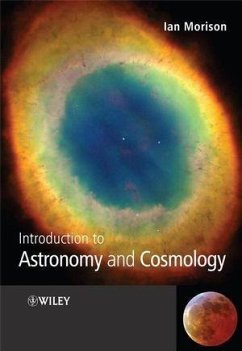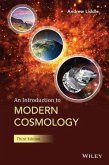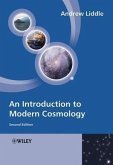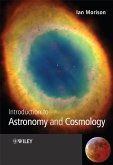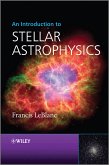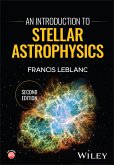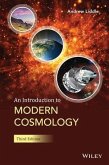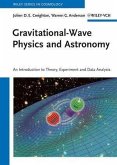Ian Morison
Introduction to Astronomy and Cosmology (eBook, ePUB)
48,99 €
48,99 €
inkl. MwSt.
Sofort per Download lieferbar

0 °P sammeln
48,99 €
Als Download kaufen

48,99 €
inkl. MwSt.
Sofort per Download lieferbar

0 °P sammeln
Jetzt verschenken
Alle Infos zum eBook verschenken
48,99 €
inkl. MwSt.
Sofort per Download lieferbar
Alle Infos zum eBook verschenken

0 °P sammeln
Ian Morison
Introduction to Astronomy and Cosmology (eBook, ePUB)
- Format: ePub
- Merkliste
- Auf die Merkliste
- Bewerten Bewerten
- Teilen
- Produkt teilen
- Produkterinnerung
- Produkterinnerung

Bitte loggen Sie sich zunächst in Ihr Kundenkonto ein oder registrieren Sie sich bei
bücher.de, um das eBook-Abo tolino select nutzen zu können.
Hier können Sie sich einloggen
Hier können Sie sich einloggen
Sie sind bereits eingeloggt. Klicken Sie auf 2. tolino select Abo, um fortzufahren.

Bitte loggen Sie sich zunächst in Ihr Kundenkonto ein oder registrieren Sie sich bei bücher.de, um das eBook-Abo tolino select nutzen zu können.
Introduction to Astronomy & Cosmology is a modern undergraduate textbook, combining both the theory behind astronomy with the very latest developments. Written for science students, this book takes a carefully developed scientific approach to this dynamic subject. Every major concept is accompanied by a worked example with end of chapter problems to improve understanding * Includes coverage of the very latest developments such as double pulsars and the dark galaxy. * Beautifully illustrated in full colour throughout * Supplementary web site with many additional full colour images, content, and latest developments.…mehr
- Geräte: eReader
- mit Kopierschutz
- eBook Hilfe
- Größe: 4.86MB
Andere Kunden interessierten sich auch für
![An Introduction to Modern Cosmology (eBook, ePUB) An Introduction to Modern Cosmology (eBook, ePUB)]() Andrew LiddleAn Introduction to Modern Cosmology (eBook, ePUB)35,99 €
Andrew LiddleAn Introduction to Modern Cosmology (eBook, ePUB)35,99 €![An Introduction to Modern Cosmology (eBook, ePUB) An Introduction to Modern Cosmology (eBook, ePUB)]() Andrew LiddleAn Introduction to Modern Cosmology (eBook, ePUB)35,99 €
Andrew LiddleAn Introduction to Modern Cosmology (eBook, ePUB)35,99 €![Introduction to Astronomy and Cosmology (eBook, PDF) Introduction to Astronomy and Cosmology (eBook, PDF)]() Ian MorisonIntroduction to Astronomy and Cosmology (eBook, PDF)48,99 €
Ian MorisonIntroduction to Astronomy and Cosmology (eBook, PDF)48,99 €![An Introduction to Stellar Astrophysics (eBook, ePUB) An Introduction to Stellar Astrophysics (eBook, ePUB)]() Francis LeblancAn Introduction to Stellar Astrophysics (eBook, ePUB)49,99 €
Francis LeblancAn Introduction to Stellar Astrophysics (eBook, ePUB)49,99 €![An Introduction to Stellar Astrophysics (eBook, ePUB) An Introduction to Stellar Astrophysics (eBook, ePUB)]() Francis LeblancAn Introduction to Stellar Astrophysics (eBook, ePUB)62,99 €
Francis LeblancAn Introduction to Stellar Astrophysics (eBook, ePUB)62,99 €![An Introduction to Modern Cosmology (eBook, PDF) An Introduction to Modern Cosmology (eBook, PDF)]() Andrew LiddleAn Introduction to Modern Cosmology (eBook, PDF)35,99 €
Andrew LiddleAn Introduction to Modern Cosmology (eBook, PDF)35,99 €![Gravitational-Wave Physics and Astronomy (eBook, ePUB) Gravitational-Wave Physics and Astronomy (eBook, ePUB)]() Jolien D. E. CreightonGravitational-Wave Physics and Astronomy (eBook, ePUB)162,99 €
Jolien D. E. CreightonGravitational-Wave Physics and Astronomy (eBook, ePUB)162,99 €-
-
-
Introduction to Astronomy & Cosmology is a modern undergraduate textbook, combining both the theory behind astronomy with the very latest developments. Written for science students, this book takes a carefully developed scientific approach to this dynamic subject. Every major concept is accompanied by a worked example with end of chapter problems to improve understanding * Includes coverage of the very latest developments such as double pulsars and the dark galaxy. * Beautifully illustrated in full colour throughout * Supplementary web site with many additional full colour images, content, and latest developments.
Dieser Download kann aus rechtlichen Gründen nur mit Rechnungsadresse in D ausgeliefert werden.
Produktdetails
- Produktdetails
- Verlag: John Wiley & Sons
- Erscheinungstermin: 18. März 2013
- Englisch
- ISBN-13: 9781118681527
- Artikelnr.: 37759328
- Verlag: John Wiley & Sons
- Erscheinungstermin: 18. März 2013
- Englisch
- ISBN-13: 9781118681527
- Artikelnr.: 37759328
- Herstellerkennzeichnung Die Herstellerinformationen sind derzeit nicht verfügbar.
Ian Morison began his love of astronomy when, at the age of 12, he made a telescope out of lenses given to him by his optician. He went on to study Physics, Mathematics and Astronomy at Oxford and in 1970 was appointed to the staff of the University of Manchester where he now teaches astronomy, computing and electronics.
He is a past president of the Society for Popular Astronomy, one of the UK's largest astronomical societies. He remains on the society's council and holds the post of instrument advisor helping members with their choice and use of Telescopes.
He lectures wi9dely on astronomy, has co-authored books for amateur astronomers and writes regularly for the two UK astronomy magazines. He also writes a monthly sky guide for the Jodrell Bank Observatory's web site and produces an audio version as part of the Jodrell Bank Podcast. He has contributed to many television programmes and is a regular astronomy commentator on local and national radio. Another activity he greatly enjoys to take amateur astronomers on observing trips such as those to Lapland to see the Aurora Borealis and on expeditions to Turkey and China to observe total eclipses of the Sun.
In 2003 the Minor Planets Committee of the International Astronomical Union named asteroid 15,727 in his honour, citing his work with MERLIN, the world's largest linked array of radio telescopes, and that in searching for intelligent life beyond our Solar System in Project Phoenix. In 2007 he was appointed to the post of Gresham Professor of Astronomy. Dating from 1597, this is the oldest astronomy professorship in the world and was once held by Christopher Wren.
He is a past president of the Society for Popular Astronomy, one of the UK's largest astronomical societies. He remains on the society's council and holds the post of instrument advisor helping members with their choice and use of Telescopes.
He lectures wi9dely on astronomy, has co-authored books for amateur astronomers and writes regularly for the two UK astronomy magazines. He also writes a monthly sky guide for the Jodrell Bank Observatory's web site and produces an audio version as part of the Jodrell Bank Podcast. He has contributed to many television programmes and is a regular astronomy commentator on local and national radio. Another activity he greatly enjoys to take amateur astronomers on observing trips such as those to Lapland to see the Aurora Borealis and on expeditions to Turkey and China to observe total eclipses of the Sun.
In 2003 the Minor Planets Committee of the International Astronomical Union named asteroid 15,727 in his honour, citing his work with MERLIN, the world's largest linked array of radio telescopes, and that in searching for intelligent life beyond our Solar System in Project Phoenix. In 2007 he was appointed to the post of Gresham Professor of Astronomy. Dating from 1597, this is the oldest astronomy professorship in the world and was once held by Christopher Wren.
Preface.
Bibliography.
Chapter 1: Astronomy, an Observational Science.
1.1 Introduction.
1.2 Galileo Galilel's proof of the Copernican theory of the solar system.
1.3 The celestial sphere and stellar magnitudes.
1.4 The celestial coordinate system.
1.5 Precession.
1.6 Time.
1.7 A second major observational triumph: the laws of planetary motion.
1.8 Measuring the astronomical unit.
1.9 Isaac Newton and his Universal law of Gravity.
1.10 Experimental measurements of G, the Universal constant of gravitation.
1.11 Gravity today: Einstein's special and general theories of relativity.
1.12 Conclusion.
1.13 Questions.
Chapter 2: Our Solar System 1 - The Sun.
2.1 The formation of the solar system.
2.2 The Sun.
2.3 Nuclear fusion.
2.4 The solar neutrino problem.
2.5 The solar atmosphere: photosphere, chromosphere and corona.
2.6 The solar wind.
2.7 The sun's magnetic field and the sunspot cycle.
2.8 Prominences, flares and the interaction of the solar wind with the
earth's atmosphere.
2.9 Solar eclipses.
2.10 Questions.
Chapter 3: Our Solar System 2 - The Planets.
3.1 What is a planet?
3.2 Planetary orbits.
3.3 Planetary properties.
3.4 Planetary atmospheres.
3.5 The planets of the solar systems.
3.6 Comets.
3.7 Questions.
Chapter 4: Extra-solar Planets.
4.1 The radial velocity (Doppler wobble) method of planetary detection.
4.2 Planetary transits.
4.3 Gravitational microlensing.
4.4 Astrometry.
4.5 Discovery space.
4.6 Selection effects and the likelihood of finding solar systems like
ours.
4.7 Questions.
Chapter 5: Observing the Universe.
5.1 Thinking about optics in terms of waves rather than rays.
5.2 The human eye.
5.3 The use of a telescope or pair of binoculars to see fainter objects.
5.4 Using a telescope to see more detail in an image.
5.5 The magnification of a telescope.
5.6 Image Contrast.
5.7 The classic Newtonian telescope.
5.8 The Cassegrain telescope.
5.9 Catadioptric telescopes.
5.10 Active and adaptive optics.
5.11 Some significant optical telescopes.
5.12 Radio telescopes.
5.13 Observing in other wavebands.
5.14 Observing the universe without using electromagnetic radiation.
5.15 Questions.
Chapter 6: The Properties of Stars.
6.1 Stellar luminosity.
6.2 Stellar distances.
6.3 Proper motion.
6.4 The absolute magnitude scale.
6.5 Colour and surface temperature.
6.6 Stellar photometry.
6.7 Stellar spectra.
6.8 Spectroscopic parallax.
6.9 The Hertzsprung-Russell Diagram.
6.10 The size of stars.
6.11 The masses and densities of stars.
6.12 The stellar mass-luminosity relationship.
6.13 Stellar lifetimes.
6.14 Questions.
Chapter 7: Stellar Evolution - The Life and Death of Stars.
7.1 Low mass stars: 0.05-0.5 solar masses.
7.2 Mid mass stars: 0.5-8 solar masses.
7.3 Variable stars.
7.4 Planetary nebula.
7.5 White dwarfs.
7.6 The evolution of a sun-like star.
7.7 Evolution in close binary systems - the Algol paradox.
>8 solar masses.
7.9 Type II supernova.
7.10 Neutron stars and black holes.
7.11 The discovery of pulsars.
7.12 Pulsars as tests for general relativity.
7.13 Black holes.
7.14 Questions.
Chapter 8: Galaxies and the Large Scale Structure of the Universe.
8.1 The Milky Way.
8.2 Other galaxies.
8.3 The universe.
8.4 Questions.
Chapter 9: Cosmology - the Origin and Evolution of the Universe.
9.1 Einstein's blunder?
9.2 Big Bang models of the universe.
9.3 The blueshifts and redshifts observed in the spectra of galaxies.
9.4 The expansion of the universe.
9.5 The steady state model of the universe.
9.6 Big Bang or Steady State?
9.7 The cosmic microwave background.
9.8 Inflation.
9.9 The Big Bang and the formation of the primeval elements.
9.10 The 'ripples' in the Cosmic Microwave Background.
9.11 How dark matter effects the cosmic microwave background.
9.12 The hidden universe: dark matter and dark energy.
9.13 The makeup of the universe.
9.14 A universe fir for intelligent life.
9.15 Intelligent life in the universe.
9.16 The future of the universe.
Index.
Bibliography.
Chapter 1: Astronomy, an Observational Science.
1.1 Introduction.
1.2 Galileo Galilel's proof of the Copernican theory of the solar system.
1.3 The celestial sphere and stellar magnitudes.
1.4 The celestial coordinate system.
1.5 Precession.
1.6 Time.
1.7 A second major observational triumph: the laws of planetary motion.
1.8 Measuring the astronomical unit.
1.9 Isaac Newton and his Universal law of Gravity.
1.10 Experimental measurements of G, the Universal constant of gravitation.
1.11 Gravity today: Einstein's special and general theories of relativity.
1.12 Conclusion.
1.13 Questions.
Chapter 2: Our Solar System 1 - The Sun.
2.1 The formation of the solar system.
2.2 The Sun.
2.3 Nuclear fusion.
2.4 The solar neutrino problem.
2.5 The solar atmosphere: photosphere, chromosphere and corona.
2.6 The solar wind.
2.7 The sun's magnetic field and the sunspot cycle.
2.8 Prominences, flares and the interaction of the solar wind with the
earth's atmosphere.
2.9 Solar eclipses.
2.10 Questions.
Chapter 3: Our Solar System 2 - The Planets.
3.1 What is a planet?
3.2 Planetary orbits.
3.3 Planetary properties.
3.4 Planetary atmospheres.
3.5 The planets of the solar systems.
3.6 Comets.
3.7 Questions.
Chapter 4: Extra-solar Planets.
4.1 The radial velocity (Doppler wobble) method of planetary detection.
4.2 Planetary transits.
4.3 Gravitational microlensing.
4.4 Astrometry.
4.5 Discovery space.
4.6 Selection effects and the likelihood of finding solar systems like
ours.
4.7 Questions.
Chapter 5: Observing the Universe.
5.1 Thinking about optics in terms of waves rather than rays.
5.2 The human eye.
5.3 The use of a telescope or pair of binoculars to see fainter objects.
5.4 Using a telescope to see more detail in an image.
5.5 The magnification of a telescope.
5.6 Image Contrast.
5.7 The classic Newtonian telescope.
5.8 The Cassegrain telescope.
5.9 Catadioptric telescopes.
5.10 Active and adaptive optics.
5.11 Some significant optical telescopes.
5.12 Radio telescopes.
5.13 Observing in other wavebands.
5.14 Observing the universe without using electromagnetic radiation.
5.15 Questions.
Chapter 6: The Properties of Stars.
6.1 Stellar luminosity.
6.2 Stellar distances.
6.3 Proper motion.
6.4 The absolute magnitude scale.
6.5 Colour and surface temperature.
6.6 Stellar photometry.
6.7 Stellar spectra.
6.8 Spectroscopic parallax.
6.9 The Hertzsprung-Russell Diagram.
6.10 The size of stars.
6.11 The masses and densities of stars.
6.12 The stellar mass-luminosity relationship.
6.13 Stellar lifetimes.
6.14 Questions.
Chapter 7: Stellar Evolution - The Life and Death of Stars.
7.1 Low mass stars: 0.05-0.5 solar masses.
7.2 Mid mass stars: 0.5-8 solar masses.
7.3 Variable stars.
7.4 Planetary nebula.
7.5 White dwarfs.
7.6 The evolution of a sun-like star.
7.7 Evolution in close binary systems - the Algol paradox.
>8 solar masses.
7.9 Type II supernova.
7.10 Neutron stars and black holes.
7.11 The discovery of pulsars.
7.12 Pulsars as tests for general relativity.
7.13 Black holes.
7.14 Questions.
Chapter 8: Galaxies and the Large Scale Structure of the Universe.
8.1 The Milky Way.
8.2 Other galaxies.
8.3 The universe.
8.4 Questions.
Chapter 9: Cosmology - the Origin and Evolution of the Universe.
9.1 Einstein's blunder?
9.2 Big Bang models of the universe.
9.3 The blueshifts and redshifts observed in the spectra of galaxies.
9.4 The expansion of the universe.
9.5 The steady state model of the universe.
9.6 Big Bang or Steady State?
9.7 The cosmic microwave background.
9.8 Inflation.
9.9 The Big Bang and the formation of the primeval elements.
9.10 The 'ripples' in the Cosmic Microwave Background.
9.11 How dark matter effects the cosmic microwave background.
9.12 The hidden universe: dark matter and dark energy.
9.13 The makeup of the universe.
9.14 A universe fir for intelligent life.
9.15 Intelligent life in the universe.
9.16 The future of the universe.
Index.
Preface.
Bibliography.
Chapter 1: Astronomy, an Observational Science.
1.1 Introduction.
1.2 Galileo Galilel's proof of the Copernican theory of the solar system.
1.3 The celestial sphere and stellar magnitudes.
1.4 The celestial coordinate system.
1.5 Precession.
1.6 Time.
1.7 A second major observational triumph: the laws of planetary motion.
1.8 Measuring the astronomical unit.
1.9 Isaac Newton and his Universal law of Gravity.
1.10 Experimental measurements of G, the Universal constant of gravitation.
1.11 Gravity today: Einstein's special and general theories of relativity.
1.12 Conclusion.
1.13 Questions.
Chapter 2: Our Solar System 1 - The Sun.
2.1 The formation of the solar system.
2.2 The Sun.
2.3 Nuclear fusion.
2.4 The solar neutrino problem.
2.5 The solar atmosphere: photosphere, chromosphere and corona.
2.6 The solar wind.
2.7 The sun's magnetic field and the sunspot cycle.
2.8 Prominences, flares and the interaction of the solar wind with the
earth's atmosphere.
2.9 Solar eclipses.
2.10 Questions.
Chapter 3: Our Solar System 2 - The Planets.
3.1 What is a planet?
3.2 Planetary orbits.
3.3 Planetary properties.
3.4 Planetary atmospheres.
3.5 The planets of the solar systems.
3.6 Comets.
3.7 Questions.
Chapter 4: Extra-solar Planets.
4.1 The radial velocity (Doppler wobble) method of planetary detection.
4.2 Planetary transits.
4.3 Gravitational microlensing.
4.4 Astrometry.
4.5 Discovery space.
4.6 Selection effects and the likelihood of finding solar systems like
ours.
4.7 Questions.
Chapter 5: Observing the Universe.
5.1 Thinking about optics in terms of waves rather than rays.
5.2 The human eye.
5.3 The use of a telescope or pair of binoculars to see fainter objects.
5.4 Using a telescope to see more detail in an image.
5.5 The magnification of a telescope.
5.6 Image Contrast.
5.7 The classic Newtonian telescope.
5.8 The Cassegrain telescope.
5.9 Catadioptric telescopes.
5.10 Active and adaptive optics.
5.11 Some significant optical telescopes.
5.12 Radio telescopes.
5.13 Observing in other wavebands.
5.14 Observing the universe without using electromagnetic radiation.
5.15 Questions.
Chapter 6: The Properties of Stars.
6.1 Stellar luminosity.
6.2 Stellar distances.
6.3 Proper motion.
6.4 The absolute magnitude scale.
6.5 Colour and surface temperature.
6.6 Stellar photometry.
6.7 Stellar spectra.
6.8 Spectroscopic parallax.
6.9 The Hertzsprung-Russell Diagram.
6.10 The size of stars.
6.11 The masses and densities of stars.
6.12 The stellar mass-luminosity relationship.
6.13 Stellar lifetimes.
6.14 Questions.
Chapter 7: Stellar Evolution - The Life and Death of Stars.
7.1 Low mass stars: 0.05-0.5 solar masses.
7.2 Mid mass stars: 0.5-8 solar masses.
7.3 Variable stars.
7.4 Planetary nebula.
7.5 White dwarfs.
7.6 The evolution of a sun-like star.
7.7 Evolution in close binary systems - the Algol paradox.
>8 solar masses.
7.9 Type II supernova.
7.10 Neutron stars and black holes.
7.11 The discovery of pulsars.
7.12 Pulsars as tests for general relativity.
7.13 Black holes.
7.14 Questions.
Chapter 8: Galaxies and the Large Scale Structure of the Universe.
8.1 The Milky Way.
8.2 Other galaxies.
8.3 The universe.
8.4 Questions.
Chapter 9: Cosmology - the Origin and Evolution of the Universe.
9.1 Einstein's blunder?
9.2 Big Bang models of the universe.
9.3 The blueshifts and redshifts observed in the spectra of galaxies.
9.4 The expansion of the universe.
9.5 The steady state model of the universe.
9.6 Big Bang or Steady State?
9.7 The cosmic microwave background.
9.8 Inflation.
9.9 The Big Bang and the formation of the primeval elements.
9.10 The 'ripples' in the Cosmic Microwave Background.
9.11 How dark matter effects the cosmic microwave background.
9.12 The hidden universe: dark matter and dark energy.
9.13 The makeup of the universe.
9.14 A universe fir for intelligent life.
9.15 Intelligent life in the universe.
9.16 The future of the universe.
Index.
Bibliography.
Chapter 1: Astronomy, an Observational Science.
1.1 Introduction.
1.2 Galileo Galilel's proof of the Copernican theory of the solar system.
1.3 The celestial sphere and stellar magnitudes.
1.4 The celestial coordinate system.
1.5 Precession.
1.6 Time.
1.7 A second major observational triumph: the laws of planetary motion.
1.8 Measuring the astronomical unit.
1.9 Isaac Newton and his Universal law of Gravity.
1.10 Experimental measurements of G, the Universal constant of gravitation.
1.11 Gravity today: Einstein's special and general theories of relativity.
1.12 Conclusion.
1.13 Questions.
Chapter 2: Our Solar System 1 - The Sun.
2.1 The formation of the solar system.
2.2 The Sun.
2.3 Nuclear fusion.
2.4 The solar neutrino problem.
2.5 The solar atmosphere: photosphere, chromosphere and corona.
2.6 The solar wind.
2.7 The sun's magnetic field and the sunspot cycle.
2.8 Prominences, flares and the interaction of the solar wind with the
earth's atmosphere.
2.9 Solar eclipses.
2.10 Questions.
Chapter 3: Our Solar System 2 - The Planets.
3.1 What is a planet?
3.2 Planetary orbits.
3.3 Planetary properties.
3.4 Planetary atmospheres.
3.5 The planets of the solar systems.
3.6 Comets.
3.7 Questions.
Chapter 4: Extra-solar Planets.
4.1 The radial velocity (Doppler wobble) method of planetary detection.
4.2 Planetary transits.
4.3 Gravitational microlensing.
4.4 Astrometry.
4.5 Discovery space.
4.6 Selection effects and the likelihood of finding solar systems like
ours.
4.7 Questions.
Chapter 5: Observing the Universe.
5.1 Thinking about optics in terms of waves rather than rays.
5.2 The human eye.
5.3 The use of a telescope or pair of binoculars to see fainter objects.
5.4 Using a telescope to see more detail in an image.
5.5 The magnification of a telescope.
5.6 Image Contrast.
5.7 The classic Newtonian telescope.
5.8 The Cassegrain telescope.
5.9 Catadioptric telescopes.
5.10 Active and adaptive optics.
5.11 Some significant optical telescopes.
5.12 Radio telescopes.
5.13 Observing in other wavebands.
5.14 Observing the universe without using electromagnetic radiation.
5.15 Questions.
Chapter 6: The Properties of Stars.
6.1 Stellar luminosity.
6.2 Stellar distances.
6.3 Proper motion.
6.4 The absolute magnitude scale.
6.5 Colour and surface temperature.
6.6 Stellar photometry.
6.7 Stellar spectra.
6.8 Spectroscopic parallax.
6.9 The Hertzsprung-Russell Diagram.
6.10 The size of stars.
6.11 The masses and densities of stars.
6.12 The stellar mass-luminosity relationship.
6.13 Stellar lifetimes.
6.14 Questions.
Chapter 7: Stellar Evolution - The Life and Death of Stars.
7.1 Low mass stars: 0.05-0.5 solar masses.
7.2 Mid mass stars: 0.5-8 solar masses.
7.3 Variable stars.
7.4 Planetary nebula.
7.5 White dwarfs.
7.6 The evolution of a sun-like star.
7.7 Evolution in close binary systems - the Algol paradox.
>8 solar masses.
7.9 Type II supernova.
7.10 Neutron stars and black holes.
7.11 The discovery of pulsars.
7.12 Pulsars as tests for general relativity.
7.13 Black holes.
7.14 Questions.
Chapter 8: Galaxies and the Large Scale Structure of the Universe.
8.1 The Milky Way.
8.2 Other galaxies.
8.3 The universe.
8.4 Questions.
Chapter 9: Cosmology - the Origin and Evolution of the Universe.
9.1 Einstein's blunder?
9.2 Big Bang models of the universe.
9.3 The blueshifts and redshifts observed in the spectra of galaxies.
9.4 The expansion of the universe.
9.5 The steady state model of the universe.
9.6 Big Bang or Steady State?
9.7 The cosmic microwave background.
9.8 Inflation.
9.9 The Big Bang and the formation of the primeval elements.
9.10 The 'ripples' in the Cosmic Microwave Background.
9.11 How dark matter effects the cosmic microwave background.
9.12 The hidden universe: dark matter and dark energy.
9.13 The makeup of the universe.
9.14 A universe fir for intelligent life.
9.15 Intelligent life in the universe.
9.16 The future of the universe.
Index.
"The book is beautifully produced and illustrated, and notable for the care that has gone into the choice of appropriate and unusual illustrations. Recommended." ( SSR , December 2009) "This is an up to date, well written, first year undergraduate textbook ... .Many people will enjoy reading it." ( The Observatory Magazine , August 2009) "A very well thought out book that lucidly covers a comprehensive range of topics in an attractive format ... .Bang up to date, and all cut up into convenient, self contained sections that can be read in a dip in, dip out sort of way." ( Astronomy Now , January 2009)
